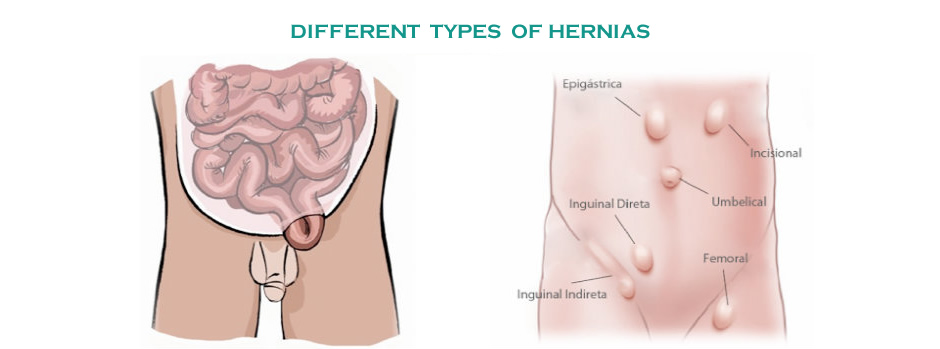A hernia is a defect, usually of muscle, whereby contents from one anatomical space enter another space where they should not be.
Common hernias occur with the ageing process around naturally weak spots in the muscular wall. These include around the umbilicus (belly button) and in the groin where normal structures pass through a canal to make their way to the perineal area (scrotum in the male).

Hernia principles:
- Hernias don’t get better by themselves. Often with time they will enlarge and cause further problems.
- Most hernia repairs are done with a quantity of lightweight mesh which incorporates into the tissues and improves long term results.
- Hernias are most commonly repaired when they are causing pain or discomfort or if they are large and therefore at risk of strangulation (the contents get stuck)
- Recovery process: Because hernia repairs involve muscle, strenuous activities such as heavy lifting, gym or other high intensity sports should not be undertaken for up to 6 weeks post repair. General activities around the house and driving can occur usually within a few days and moderate level activities (most workplace activities) after one to two weeks.
Some common hernia types:
Umbilical hernias
These are often felt as a lump around the belly button and may make it seem like an “outie” instead of an “innie”. Umbilical hernias are very common and generally don’t cause any problems unless they enlarge (which most will with time). Surgery in most cases involves a small cut underneath or above the umbilicus and a mesh repair of the underlying muscle defect.
Inguinal and other groin hernias
These usually present as a lump or discomfort in the lower groin and will enlarge with time. A standard mesh repair can be done either with an open approach (7-8cm cut in the lower groin) or keyhole by coming from underneath (still using mesh). A laparoscopic (keyhole) approach may have advantages for those with hernias on both sides as no further cuts are required to fix both and for younger patients looking to get back to work quickly as the recovery is slightly quicker. One day in hospital is usual although some patients may not require an overnight stay. Strenuous activities such as heavy lifting, gym or other high intensity sports should not be undertaken for up to 6 weeks. For couples looking for permanent contraception, vasectomy can be easily performed during laparoscopic inguinal hernia surgery with no further cuts required.
Incisional Hernias
These are hernias related to past operations on the abdomen including Caesarean sections, laparotomies, keyhole surgery and other procedures. There are usually associated adhesions and scar tissue around the hernia site due to the previous operation. A decent size sheet of mesh carefully sutured into place is usually required to repair the hernia. This can sometimes be done with keyhole surgery although the advantages of this approach are not always apparent.